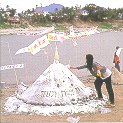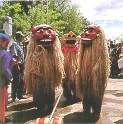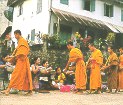| The following day, the intercalary day
(Mu Nao), is reserved for resting and, in former times, all work was prohibited. To
ensure that the calendar year corresponds to the solar year, on certain years the
astrologers designate two intercalary days. On this intermediate day, a procession
is held to honor the spirit of the new year. Activities commence to the sound of
drums as the legendary guardian deities, Phou Nheu (grandfather) and Nha Nheu
(grandmother), emerge from the Shrine of the Grand Deities (Ho Thevada Luang) in the Wat
Aham compound where their red wooden masks and costumes have been enshrined during the
year. The little lion Singkao Singkham (Jewel Lion/Gold Lion), which is believed to
be the representation of an indigenous King, accompanies them. After ritual
offerings, Phou Nheu and Nha Nheu perform a traditional dance in a gesture to purify the
land and to dispel evil spirits. After the dance, children excitedly try to collect
the hair that has fallen from Phou Nheu and Nha Nheu to keep as a good luck charm.
The trio then proceeds to Wat Tat where they are joined by the New Year Queen (Nang Sang
Khan) who represents one of the seven daughters of Kabilaphom, a legendary Heavenly
King. Upon collecting her father's four-faced head, they all join the main
procession to Wat
Xieng Thong, which includes important community and religious leaders, monks
and novices, as well as several elephants and their indigenous trainers. After
arriving at Wat Xieng Thong and accepting offerings from the people, Phou Nheu and Nha
Nheu perform their mythical dance once again. |


